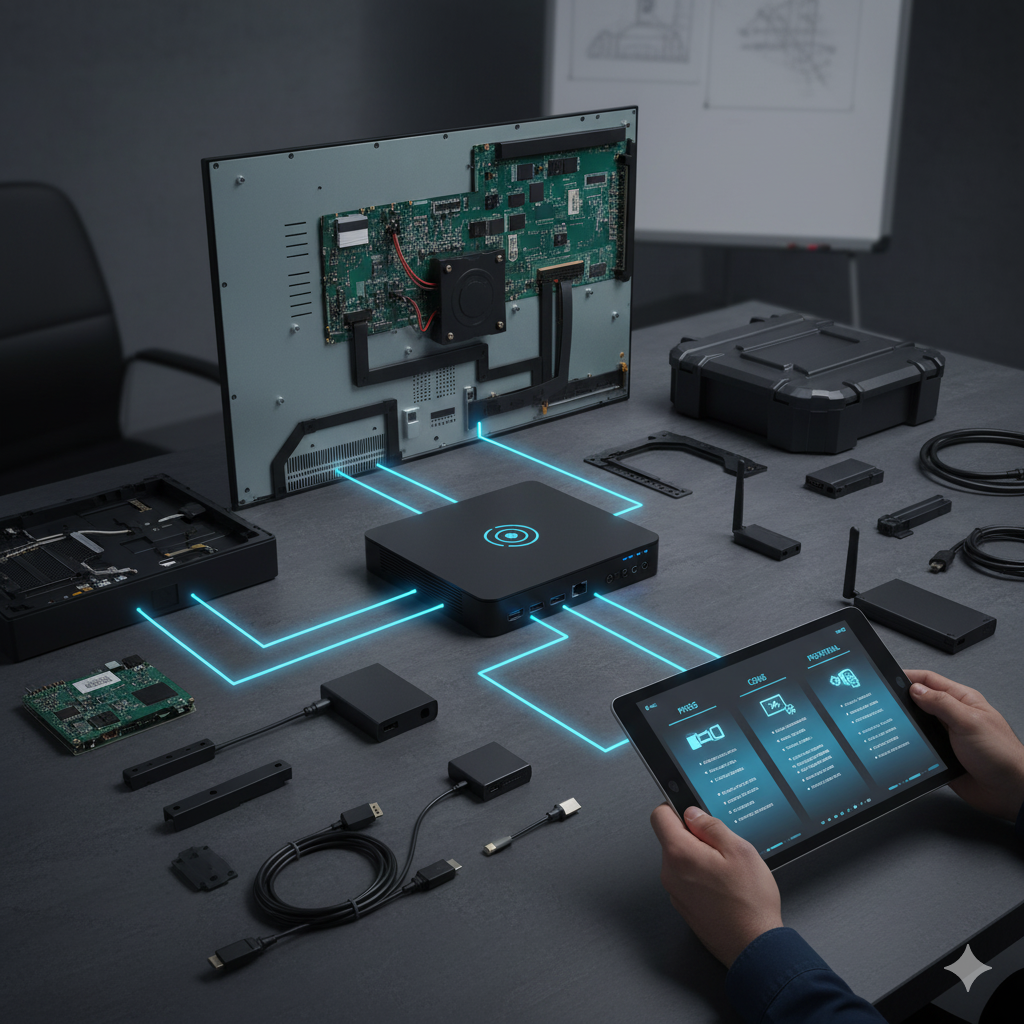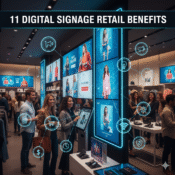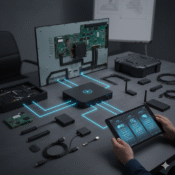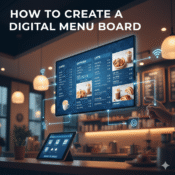
The Buyer’s Guide to Digital Signage Hardware: Pros, Cons and Potential
Choosing the right digital signage hardware is one of the most critical steps toward a successful signage deployment. Whether it’s a single retail screen or a global network of displays, the hardware forms the backbone of performance, reliability, and visual impact.
As technology continues to evolve, so does the digital signage hardware landscape—with innovations in display types, media players, connectivity, and energy efficiency. From LED video walls to interactive OLED displays, businesses now have more options than ever to deliver compelling visual experiences.
At ScreensHub, we specialize in providing end-to-end digital signage hardware solutions—from displays and media players to networking infrastructure and enclosures. Our expert team designs and deploys integrated systems tailored to every business environment, ensuring seamless performance, scalability, and support.
Core Components of Digital Signage Hardware
Displays
The display is the visual centerpiece of every digital signage setup. Choosing the right type depends on the installation environment, content type, and budget.
Common display technologies include:
- LCD Displays – Affordable and versatile, ideal for indoor environments.
- LED Displays – Bright, durable, and scalable, perfect for large outdoor or indoor walls.
- OLED Displays – Sleek, high-quality visuals with deep contrast and flexibility for modern spaces.
- ePaper Displays – Low-power, glare-free, and best suited for informational and pricing signage.
Media Players
The media player powers your content—decoding, scheduling, and displaying it across the network. Options range from System-on-Chip (SoC) solutions integrated into the display to dedicated hardware like BrightSign, Android, or Windows-based players, depending on performance needs.
Mounting and Enclosures
Proper mounting and enclosures ensure safety, visibility, and durability. For indoor displays, aesthetics matter; for outdoor screens, weatherproofing and security are essential.
Networking Equipment
A reliable network infrastructure ensures content is delivered consistently and updated remotely. Both wired (Ethernet) and wireless (Wi-Fi or cellular) connections have their advantages, depending on the deployment scale and environment.
At ScreensHub, we integrate all these core components into cohesive ecosystems that maximize performance, minimize downtime, and simplify management.
Detailed Breakdown of Display Types: Pros, Cons, and Potential
LCD Displays
Pros:
- Affordable and widely available
- Excellent image quality for indoor environments
- Energy-efficient and easy to maintain
Cons:
- Limited brightness for outdoor use
- Narrow viewing angles compared to LED
Best Use Cases: Retail shops, restaurants, offices, and healthcare facilities.
LED Displays
Pros:
- Exceptional brightness and visibility in all lighting conditions
- Scalable to any size or shape
- Long lifespan and minimal image burn-in
Cons:
- Higher initial cost
- Increased energy consumption
Best Use Cases: Stadiums, billboards, large retail environments, and event venues.
OLED Displays
Pros:
- Superior color contrast and thin, lightweight design
- Flexible form factor for modern architecture
- Minimal bezel, ideal for premium installations
Cons:
- Premium cost
- Shorter lifespan compared to LED
Best Use Cases: High-end retail, corporate lobbies, museums, and luxury spaces.
ePaper Displays
Pros:
- Extremely low power consumption
- Sunlight readable and glare-free
- Ideal for static or infrequently updated content
Cons:
- Limited refresh rate and color capabilities
Best Use Cases: Transit schedules, menu boards, retail pricing, and digital shelf labels.
ScreensHub helps businesses select the right display technology based on environment, content type, and operational needs—balancing visual impact with cost-effectiveness.
Media Players: Choosing the Right Hardware
Media players determine how your content runs—smoothly or with limitations. The right choice depends on content complexity, integration requirements, and scalability.
Basic Players (SoC Displays)
Pros: Integrated within the display, affordable, and energy-efficient.
Cons: Limited processing power and flexibility.
Best For: Simple menu boards or basic static signage.
Mid-Tier Commercial Players
Pros: Balance between cost and performance.
Cons: Moderate scalability limits.
Best For: Retail, corporate, and education applications.
High-End Players
Pros: Superior processing power, 4K/8K playback, supports interactivity and video walls.
Cons: Higher investment cost.
Best For: Complex, high-performance installations.
Operating System Comparison
- Android: Flexible, cost-effective, supports custom apps.
- Windows: Powerful and compatible with most CMS solutions.
- Linux: Stable and secure, ideal for enterprise-level control.
- Proprietary OS: Highly optimized for specific signage software.
ScreensHub curates media player options tailored to your business goals—ensuring compatibility, performance, and longevity.
Mounting and Enclosures Considerations
Mounting solutions influence both the safety and aesthetics of digital signage installations. Poorly chosen mounts can lead to visibility issues or damage.
Indoor Installations
Focus on space efficiency and design integration—especially in corporate or retail environments.
Outdoor Installations
Require weatherproof enclosures, anti-vandal features, and proper ventilation to protect from dust, heat, and moisture.
ScreensHub’s Expertise
Our professional installation services ensure that every display is securely mounted, optimally positioned, and compliant with safety standards for both indoor and outdoor environments.
Networking and Connectivity
Reliable networking ensures that your content stays dynamic and up-to-date.
Wired Connections (Ethernet)
Pros: Stable, fast, and secure.
Cons: Limited flexibility in placement.
Wireless Connections (Wi-Fi / Cellular)
Pros: Flexible and easier to deploy in remote locations.
Cons: Can be affected by signal interference and bandwidth issues.
At ScreensHub, we design networking solutions that guarantee uptime, security, and scalability for any deployment size—whether it’s a single-store setup or a multi-location enterprise network.
Cost Considerations and Total Cost of Ownership (TCO)
Investing in digital signage hardware goes beyond the upfront purchase price. Businesses should consider the total cost of ownership (TCO), which includes:
- Energy Consumption: LED and OLED displays vary in power efficiency.
- Maintenance Costs: Regular updates, replacements, and servicing.
- Warranty & Support: Reliable after-sales support reduces downtime.
- Upgrade Path: Choosing modular systems allows easy scalability.
ScreensHub offers cost-effective hardware packages with transparent pricing, flexible financing options, and long-term support for sustainable ROI.
Installation, Maintenance, and Scalability
A professional installation ensures optimal screen performance, alignment, and longevity. Post-installation, scheduled maintenance keeps your hardware running efficiently.
Best Practices
- Proper ventilation to prevent overheating
- Secure cable management for safety
- Regular firmware and software updates
Scalability should also be part of your hardware strategy—allowing future expansion without replacing your existing setup.
ScreensHub’s managed services cover installation, remote monitoring, and proactive maintenance to keep your network performing at its best.
Future-Proofing Your Hardware Investment
Technology evolves rapidly—future-proofing ensures your investment stays relevant.
Emerging Trends
- AI-Optimized Displays for audience targeting
- Flexible & Transparent Screens for design innovation
- IoT Integration enabling real-time data-driven content
- Energy-Efficient Hardware reducing operational costs
ScreensHub focuses on modular and upgradable hardware ecosystems that evolve with your business, ensuring long-term compatibility with emerging technologies
Conclusion
Selecting the right digital signage hardware involves balancing performance, environment, and budget. From display types and media players to mounting, networking, and maintenance—each decision shapes the success of your digital signage strategy.
ScreensHub stands as your trusted partner in creating high-performance, scalable, and future-ready digital signage systems. With expert consultation, tailored hardware solutions, and comprehensive post-sale support, we help you transform visual communication into tangible business results.
Explore our full range of digital signage hardware solutions at screenshub.com and get personalized guidance from our experts to power your next signage project.



